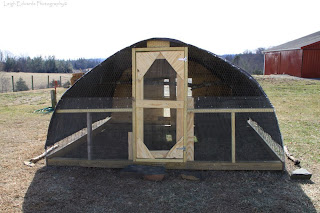By Leigh -
Quick answer:
Coop:
- 4 square feet (sq ft) of floor space per Large Fowl (LF) chicken
- 3 square feet of floor space per Bantam chicken
- 1 square foot of ventilation per 10 sq ft of floor space
Perch Space:
- 12 inches of perch space per LF chicken
- 9 inches of perch space per Bantam chicken
Perch Type:
- Perches should be positioned at least 12” to 18” away from the wall for head/tail space.
- Chickens need a minimum of 18" to 24" of head space above the perch. Remember - they have to fly up there and you don't want them banging their heads each time they jump for the roost!
- 2”x2” boards with the edges rounded off may be used for bantam breeds
- LF do best roosting on the 4” side of a 2”x4” with rounded edges.
- Natural branch roosts may also be used (minimum diameter of 3”-4” (but not all types of wood are healthy for chickens, so check prior to using.)
Nest Boxes:
- 12”x12” is the standard size for nest boxes, but your chickens won’t mind slightly smaller or larger boxes (provided they fit comfortably).
- Minimum of 1 nest box for every 3 laying hens
Run:
- 10 Sq Ft of ground space per LF chicken
- 7.5 Sq Ft of ground space per Bantam chicken

It can be confusing for those new to chickens to wade through the variety of information on proper coop and run square footage for their flock. Manufacturers selling small “doll house” coops often tout their structure as being able to house up to “X” amount of birds… and often those numbers are misleading or not appropriate for the birds or the buyer’s needs.
In general, you should have a minimum of 3-4 square feet of floor space for each large fowl (LF) bird in your flock and 2-3 square feet for bantam breeds.
Note I specify “floor space.” What this means is that it doesn’t really matter how tall your coop is – just how wide and how deep. Thus, a 4’x4’ coop that is 3’ high can house just as many birds as a coop that is 4’x4’ and 7’ high.

During the day, chickens spend most of their time on the ground. In the event of bad weather when the chickens don’t want to leave the safety of their coop, crowded floor space may cause tension and bullying.
Imagine two scenarios. In the first, you are stuck in a standard-size elevator with 10 people… and one of those people a bully who has decided he simply does not like you. The more bored or stressed he gets, the more that bully picks on you. Yikes, right?
Now imagine you are with those same 10 people in a diner. It is still a limited space, but if you stay in one corner of the diner eating your food, reading your book and minding your own business, the bully is less likely to move from his seat to pick on you. You can also move away if he comes near. More space means it will be harder for him to corner you.

Yes – you can put more birds into a smaller space, but the more crowded your birds are, the more problems can occur, such as feather picking, over-breeding of one hen (if you have a rooster) and even cannibalism.

As for run space, 10 sq ft of ground space per LF chicken and 7.5 sq ft per bantam is generally sufficient. This also depends on your ability to allow your flock to free range. If your flock is able to free range all day, every day, then you may not need much of a run at all. Yet even for those who free range almost all the time, there still may be times your birds need to be confined on a pretty day. Perhaps there is a hawk that has decided to make a nest in a nearby tree and feast upon your flock, or perhaps a stray dog has been frequenting your property. It’s a wise thing to have a “safe place” for your birds to be outside when they can’t free range.
On the other hand, of your flock is rarely able to free range or only free range for a couple hours a day, you will want a bigger run. They need room to stretch their legs, scratch, find bugs and avoid other flock members when necessary. While the coop is like a chicken dormitory for sleeping, the run is the place they will be in for the majority of their active waking hours.

Providing plenty of perches, stumps, a dust bath and other “chicken furniture” can go a long way to alleviate boredom and stress-related flock issues.

The last thing to consider when building your coop and run is just how addictive chickens are. If you can, build a larger coop than you think you will need… coops have a funny way of filling themselves up rather quickly!

Happy chickening!
- Leigh
*
No comments:
Post a Comment